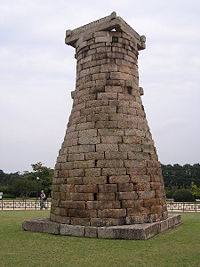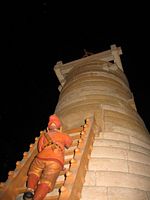Difference between revisions of "Cheomseongdae" - New World Encyclopedia
Dan Davies (talk | contribs) |
Dan Davies (talk | contribs) |
||
| Line 1: | Line 1: | ||
{{claimed}} | {{claimed}} | ||
{{koreanname|image=[[Image:Cheomseongdae.jpg|200px]]|hangul=첨성대|hanja=瞻星臺|rr=Cheomseongdae|mr=Ch'ŏmsŏngdae}} | {{koreanname|image=[[Image:Cheomseongdae.jpg|200px]]|hangul=첨성대|hanja=瞻星臺|rr=Cheomseongdae|mr=Ch'ŏmsŏngdae}} | ||
| − | '''Cheomseongdae''' is an [[astronomical observatory]] in [[Gyeongju]], [[South Korea]]. Cheomseongdae means ''star-gazing tower'' in Korean. Cheomseongdae is one of the oldest surviving observatories in [[East Asia]], and one of the oldest scientific installations on Earth. It dates to the | + | '''Cheomseongdae''' is an [[astronomical observatory]] in [[Gyeongju]], [[South Korea]]. Cheomseongdae means ''star-gazing tower'' in Korean. Cheomseongdae is one of the oldest surviving observatories in [[East Asia]], and one of the oldest scientific installations on Earth. It dates to the 7th century to the time of kingdom of [[Silla]], which had its capital in Gyeongju. Cheomseongdae was designated as the country's [[national treasures of Korea|31st national treasure]] on December 20 1962 |
== Overview == | == Overview == | ||
| − | According to ''[[Samguk Yusa]]'', Cheomseongdae was constructed under the reign of [[Queen Seondeok of Silla|Queen Seondeok]] (632-647) near the capital of the kingdom. ''Cheomseongdae'' means "star gazing platform". The tower is built out of 362 pieces of cut | + | According to ''[[Samguk Yusa]]'', Cheomseongdae was constructed under the reign of [[Queen Seondeok of Silla|Queen Seondeok]] (632-647) near the capital of the kingdom. ''Cheomseongdae'' means "star gazing platform". The tower is built out of 362 pieces of cut granite which some claim represent the 362 days of the moon|lunar year. Some surveys of the site have indicated that there are 366 blocks. It has 27 circular layers of stones (some associate it with the fact that Queen Seondeok was considered to be the 27th ruler of Silla) surmounted by a square structure. 12 of the layers are below the window level and 12 are above. There are 12 large base stones set in a square, with three stones on each side. These sets of 12 may symbolize the months of the year. |
The tower is 5.7 meters wide at the base and 9.4 meters tall, and filled with earth up to the level of the window. Its construction style parallels that used at the [[Bunhwangsa|Bunhwangsa Temple]] in Gyeongju. | The tower is 5.7 meters wide at the base and 9.4 meters tall, and filled with earth up to the level of the window. Its construction style parallels that used at the [[Bunhwangsa|Bunhwangsa Temple]] in Gyeongju. | ||
| Line 27: | Line 27: | ||
*[http://www.orientalarchitecture.com/kyongju/cheomseongdaeindex.htm Asian Historical Architecture page on Cheomseongdae] | *[http://www.orientalarchitecture.com/kyongju/cheomseongdaeindex.htm Asian Historical Architecture page on Cheomseongdae] | ||
*[http://www.lifeinkorea.com/Travel2/kyongju/193 Travel in Korea Cheomsongdae information page] | *[http://www.lifeinkorea.com/Travel2/kyongju/193 Travel in Korea Cheomsongdae information page] | ||
| + | *[http://www.indiana.edu/~easc/resources/korea_slides/science/9-1.htm]Indiana University Resources. Retrieved February 13th, 2006. | ||
| + | *[http://www.indiana.edu/~easc/resources/korea_slides/science/9-1.htm]. Indiana University Resources Retrieved February 13th, 2006. | ||
[[Category:Philosophy and religion]] | [[Category:Philosophy and religion]] | ||
Revision as of 17:08, 20 April 2007
| Cheomseongdae | ||||||||
|---|---|---|---|---|---|---|---|---|
 | ||||||||
| Korean name | ||||||||
|
Cheomseongdae is an astronomical observatory in Gyeongju, South Korea. Cheomseongdae means star-gazing tower in Korean. Cheomseongdae is one of the oldest surviving observatories in East Asia, and one of the oldest scientific installations on Earth. It dates to the 7th century to the time of kingdom of Silla, which had its capital in Gyeongju. Cheomseongdae was designated as the country's 31st national treasure on December 20 1962
Overview
According to Samguk Yusa, Cheomseongdae was constructed under the reign of Queen Seondeok (632-647) near the capital of the kingdom. Cheomseongdae means "star gazing platform". The tower is built out of 362 pieces of cut granite which some claim represent the 362 days of the moon|lunar year. Some surveys of the site have indicated that there are 366 blocks. It has 27 circular layers of stones (some associate it with the fact that Queen Seondeok was considered to be the 27th ruler of Silla) surmounted by a square structure. 12 of the layers are below the window level and 12 are above. There are 12 large base stones set in a square, with three stones on each side. These sets of 12 may symbolize the months of the year.
The tower is 5.7 meters wide at the base and 9.4 meters tall, and filled with earth up to the level of the window. Its construction style parallels that used at the Bunhwangsa Temple in Gyeongju.
The Cheomseongdae is one of the oldest surviving observatories in East Asia, though some claim that Cheomseongdae was not suitable for astronomical observation. Others posit that it was used for astrology rather than astronomy, though during that era there was little differentiation between the two. Some scholars have argued that the Cheomsongdae's design was heavily influenced by Buddhism, noting similarities between its design and Mount Sumeru, the center of the world according to Buddhist mythology.
Notes
ReferencesISBN links support NWE through referral fees
- Jeon, Sang-woon. (1998). A history of science in Korea. Seoul:Jimoondang. ISBN 89-88095-11-1
- Nha, Il-seong. Silla's Cheomseongdae. (2001) Korea Journal 41(4), 269-281. [1]
- Song, Sang-Yong. (1983). A brief history of the study of the Ch'ŏmsŏng-dae in Kyongju. Korea Journal 23(8), 16-21. [2]
External links
- Asian Historical Architecture page on Cheomseongdae
- Travel in Korea Cheomsongdae information page
- [3]Indiana University Resources. Retrieved February 13th, 2006.
- [4]. Indiana University Resources Retrieved February 13th, 2006.
Credits
New World Encyclopedia writers and editors rewrote and completed the Wikipedia article in accordance with New World Encyclopedia standards. This article abides by terms of the Creative Commons CC-by-sa 3.0 License (CC-by-sa), which may be used and disseminated with proper attribution. Credit is due under the terms of this license that can reference both the New World Encyclopedia contributors and the selfless volunteer contributors of the Wikimedia Foundation. To cite this article click here for a list of acceptable citing formats.The history of earlier contributions by wikipedians is accessible to researchers here:
The history of this article since it was imported to New World Encyclopedia:
Note: Some restrictions may apply to use of individual images which are separately licensed.
